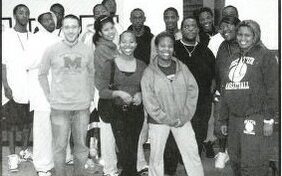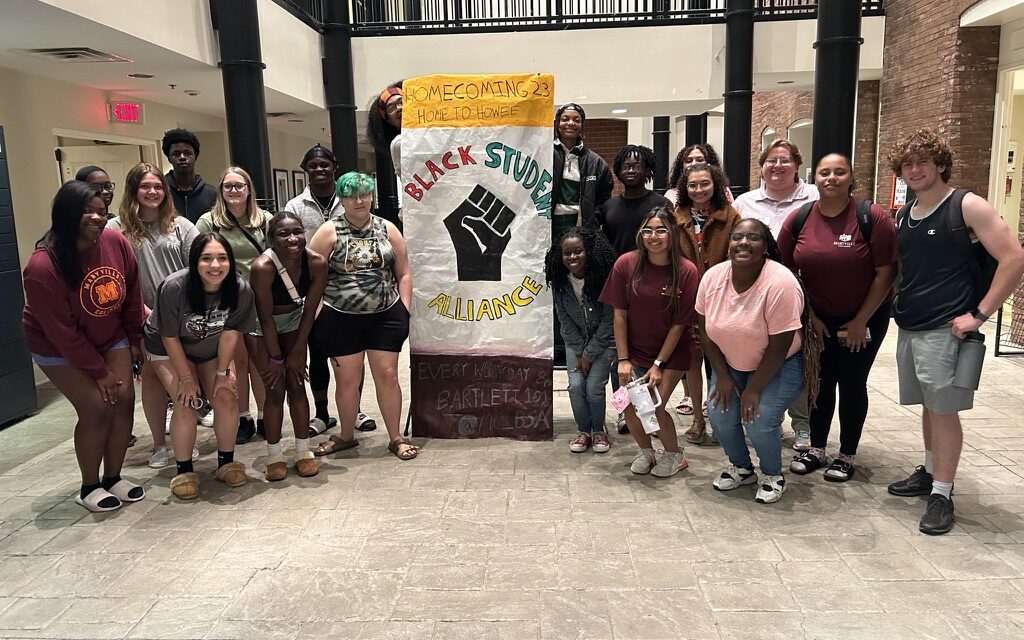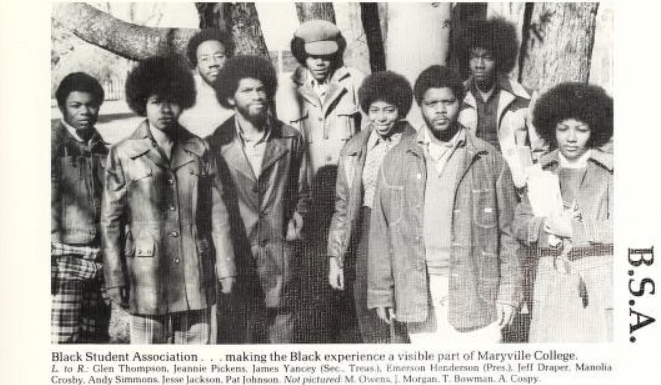The importance of Black Student Alliance at Maryville College
Students coming into Maryville College are presented with an ideal image of an inclusive, all-encompassing environment that can offer anyone the opportunity to succeed, regardless of identity or cultural background. Although the actuality of that presentation may come up short, there are efforts being made to fulfill that promise through multiple aspects of campus life. An often overlooked component of this is Black Student Alliance (BSA).
With a mission statement emphasizing the importance of education and camaraderie with all members of society, BSA is a component of campus life that highlights the struggles and advantages of being a minority student on campus. As the United States becomes more and more politically divided, and polarization spills over onto campuses as seemingly inclusive as MC, the essential nature of BSA becomes increasingly clear every day.
Launched as the Black Student Association in the mid-’70s and being referred to as the Black Student Union for a brief moment in the ’90s at MC, what is now known as the Black Student Alliance was born out of a need to make the black experience a visible aspect of Maryville College. A member of the organization decades ago, Denise Hinds (‘80), has achieved a decorated and successful career following her time as a student here, receiving numerous accolades and recognition for her sociological endeavors.
Honored with the Alumni Citation in early 2023 and serving as a member of the Maryville College Alumni Association’s Diversity Task Force since its formation in 2020, Hinds knows firsthand the ways in which MC’s inclusive attitude has changed over the years, and where it can still improve.
“When I went to MC in the late ’70s, early ’80s, there was only the Black Students Association, and I believe it was just getting off the ground,” she said. “I initially did join that group, but I don’t remember it being very strong, and I didn’t stay a member long…”
When asked about her time at MC as a Black student, Hinds described how the college was bipartisan in efforts of diversity and inclusion. Not taking a particular stance on anything, Maryville College created an environment that fostered BSA’s need for the Black experience to be pushed into visibility.
“Back then, I would describe MC, as a Black student, as a very white institution…the school didn’t do anything specifically to encourage or discourage students of color,” she said. “Those of us who came to MC kind of learned to find our own way and create community and support in whatever ways we could find it.”
Although this organized effort among students to come together through shared experiences as a result of Maryville College’s neutrality on inclusivity was regarded as commendable, the lack of progressive effort at an institutional level is perceived by some as ignoring a problem. Maryville College is an institution that can only thrive if all members of its student body’s voices are actually being heard and taken into consideration, which as Hinds pointed out, was something that was not being done at the time.
Today, efforts are being made to promote an equitable, fair experience for the entire student body, demonstrated through the promotion of the MC Division of Student Affairs’ Diversity, Equity and Inclusion initiative, but Hinds says there is still a need for improvement in multiple aspects of the institution.
“I still feel MC has a long way to go, though,” she said. “This is why I’m on the Diversity Task Force and trying to support this cause in any way I can … I would love to see how the course curriculum is addressing issues of race in their classes, [and] I’d like to hear how present Black students experience the campus and campus living on a daily basis, as a Black student. Are students experiencing racism at MC today? How does this show up? Are professors being mandated to take DEI training? These are just some of the questions I have that I’m still assessing for myself.”

Another BSA alum, Colber Prosper (’08), describes his time at Maryville College as a complicated endeavor. Author of No Entry: Examining the Powers that Undermine Our Full Potential, a book detailing how to better realize one’s full potential in the face of adversity and challenge the structures of power in society, Prosper has discussed his own experiences facing discrimination on college campuses in length.
“I have a love-hate relationship with the institution,” he said. “I found my purpose; I was intellectually challenged; I had a place that I had friends from. It meant a lot to me … but also it was at that time of my life one of the hardest periods of my life. I didn’t feel supported; I didn’t feel welcomed; I felt like I was a second-class student. I was threatened, it was a difficult time and I didn’t understand why it was so tough because of my complexion. I love the school, but I also hate it because I lost pieces of myself there.”
Looking back on his time as a student, Prosper reflected on the importance of organizations like BSA on campus and how even if minority students can’t find support through the school on a larger scale, they can still find a sense of community and belonging through student solidarity.
“I don’t know what I would have done if I wasn’t a part of BSA. It was everything to me,” he said. “I learned so much through the support, the camaraderie and the love that we have for each other. That organization kept me enrolled, engaged and identified. I identify as Haitan-African-American, and I didn’t experience racism to that extent until I moved to Tennessee. So BSA was home for me; it was critical, and I think the institution underestimates that, and [that] they should be supporting organizations like BSA.”
When asked about whether he believes Maryville College is genuinely putting in the effort to become a more equitable, uplifting environment for all students, Prosper paused.
“I can’t judge people’s authenticity or where their intentions come from,” he said. “Immanuel Kant would say that that’s probably the only good thing we have is our intentions, and the way they work out is something else. I think in our time we’ve learned that intention needs to be followed up with good practice.
“All I can say is that in Maryville College’s history, we’ve had so many missed opportunities to be more of an inclusive and equitable place. So for me, any new initiative, if I compare it to the past and all the missed opportunities and all the ways in which we cut initiatives or created barriers of inclusiveness, the proof needs to be in the pudding…”
“I need to see the data. I need to see how things are changing, before I actually believe it, because very few things in our recent past have shown that we’ve made an intentional effort to change the system, the status quo. So, if you’re looking at the receipts, I don’t see it, and that’s what I’m gonna need to believe that we’re actually making something different.”
Those are challenges that currently enrolled students of color still wrestle with. BSA currently meets at 8 p.m on Wednesdays in Bartlett Hall, Room 101. Weekly, members are often proposed with a question to prompt discussion. Questions range from lived experiences like, “What does it feel like to be a minority on campus or in Maryville in general?,” to queries that are more retrospective and interpersonal. Questions like “What is privilege to you?” and “Should you live to represent a group?” help spark open conversation where members are challenged to think about their own beliefs and reflect on the world around them.
These types of discussion lead members to create a dialogue in which students discuss their own experiences in a “place where they can see that they’re not alone and can share both the similarities and the diversity of their experience,” said current BSA Co-President Lavarius Thenthirath.
An oft-discussed topic is the level of diversity promoted in the college’s marketing efforts. Maryville can come off as facetious in its online marketing of the campus, often using minorities in promotional material to showcase a much more diverse environment than is truly present, Thenthirath said, adding that he hears much discussion from students regarding how Maryville College seems to often misrepresent the promotion of diversity on campus.
“On one hand, you want them to promote their diversity groups, and you want them to encourage people to come,” he said. “But on the other hand, a lot of times it seems like they’re misrepresenting their level of diversity. A lot of people will say whenever the cameras are out for the MC official page and they’re a minority, the camera always ends up including them somehow…”
“I want them to be able to promote their support for diversity without having to misrepresent the proportion [of white students compared to BIPOC students]. That’s a misrepresentation. We want to be seen, but we want to be seen for what we are, and what we could be.”

Co-president of BSA, Jean Miracle, stated that this marketing tactic is one of the reasons that she ultimately decided to enroll at Maryville College.
“I feel like they showcased that they were very diverse, especially on their website,” she said. “And that was one of the reasons why I came to Maryville, because I saw all of the diverse students on their homepage. Once I noticed that it wasn’t diverse, that was part of the reason why I joined BSA as a regular member.”
The perceived overemphasis on diversity by minority students can foster a false sense of security concerning campus life, Thentirath and Miracle added. But once a student arrives and begins to feel underrepresented and unsupported, who do they turn to for support? Miracle said that organizations on campus that specifically cater to the advancement of marginalized communities help alleviate these grievances tenfold.
“BSA is important because it creates that safe space for students of color on campus where they can come and vent about their problems—not just in Maryville College, but in Maryville as a whole,” she said.
Madison Taylor (‘23) experienced a similar journey during her time as a student at Maryville College. Coming in, Taylor envisioned a more diverse community, with the actuality falling short of her preconceived vision.
“While the college did emphasize diversity in its promotional materials, the extent of diversity on campus was not as extensive as I had envisioned or what I felt was advertised to me. I feel like this emphasizes the need for transparent and accurate representations in higher education marketing,” said Taylor.“
When asked how the college can do better at an institutional level, Taylor proposed that Maryville College could increase its commitment to listening to minority voices on issues that actively concern them.
“I believe that the college should actively seek out more opinions from BIPOC students,” she said. “Actively involving these communities in decision-making processes can contribute to a more comprehensive understanding of their needs and concerns, leading to more effective initiatives and policies that promote true inclusivity and equity…”
“By valuing diverse perspectives, the college can further strengthen its commitment to creating an environment where all students feel heard and supported,” Taylor said.

